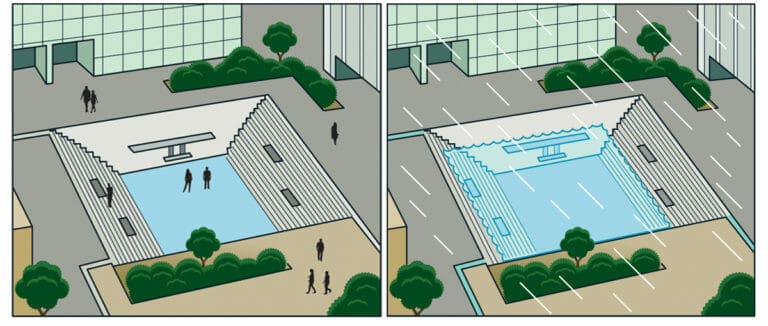Illustration: a “floodable park” helps drain rising waters, such as stormwater, from surrounding areas.
Floodable parks, salty lettuce, and other tools for a soggy planet
As sea levels rise, people with expertise in keeping water at bay are going to become very popular. Many of them will likely be Dutch. The Netherlands has been constructing flood barriers for centuries and added a massive network of dams and levees after a 1953 flood killed 1,835 people. Twenty-six percent of the country is below sea level. Schoolchildren are taught how to swim with their clothes and shoes on to prepare them for floods.
Hundreds of years of trial and error, plus a nationwide acknowledgment that climate change is a very real thing, have put the Dutch ahead of the curve when it comes to planning for encroaching waters. Here are a few of their innovations.
The Water Square
Imagine a standard European plaza where people meet to chat, drink coffee, read the paper, play chess—all your classic plaza activities. Now imagine it nestled snugly in a giant concrete soup bowl. Water Square Benthemplein in Rotterdam was built with floodable amenities like stone benches. When rains come, gutters set into the sidewalks carry water away from nearby buildings and into the plaza, turning it into a temporary reservoir.
Salt-Tolerant Crops
Dutch farmland is already experiencing saltwater intrusion—and […]
[h2oIQ editor’s note: we highly recommend the rest of the short, source article, notably their last section.]
Full article: How Is the Netherlands Preparing for Sea Level Rise?
More about rising seal levels:
Fast and Getting Faster: The Verdict on Sea Level Rise from the Latest National Climate Assessment
Water World: Sea Level Rise, Coastal Floods and Storm Surges
Satellite Snafu Masked True Sea Level Rise for Decades
Keeping score on Earth’s Global Sea-Level Rise
On the Chesapeake, A Precarious Future of Rising Seas and High Tides
‘Living With Water’: Facing Climate Change, Cities Trade Sea Walls for Parks

